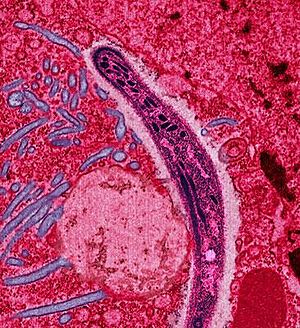Plasmodium facts for kids
Quick facts for kids Plasmodium |
|
|---|---|
 |
|
| Plasmodium sporozoite | |
| Scientific classification | |
| Kingdom: | |
| Superphylum: | |
| Phylum: | |
| Class: | |
| Order: | |
| Family: | |
| Genus: |
Plasmodium
|
Plasmodium, often called the malaria parasite, is a tiny living thing that causes malaria. It's a type of parasite, which means it lives on or in another living thing and gets its food from it. There are about 200 different kinds, or species, of Plasmodium.
When these tiny parasites infect someone, it causes a serious illness called malaria. Malaria is a very dangerous disease that is common in warm, wet places called the tropics. The Plasmodium parasite needs two different hosts to complete its life cycle. It lives part of its life inside a mosquito and part of its life inside a vertebrate animal, like a human.
Life Cycle of Plasmodium
The life cycle of the Plasmodium parasite is quite complex. It goes through many different stages inside both the mosquito and the animal it infects.
Here are the main stages:
- Sporozoites: When an infected mosquito bites an animal (like a human), it injects tiny sporozoites into the animal's blood.
- Hypnozoites: Some sporozoites can go to the liver and hide there. They can stay quiet for a very long time, sometimes even for many years, without causing any problems.
- Merozoites: Other sporozoites, or those that wake up from the liver, change into merozoites. These merozoites then infect the red blood cells in the blood.
- Trophozoites and Schizonts: Inside the red blood cells, the merozoites grow into trophozoites. These trophozoites then divide many times to form schizonts, which produce even more merozoites. These new merozoites burst out of the red blood cells to infect more red blood cells, making the person feel sick.
- Gametocytes: Some of the parasites in the red blood cells change into special male and female forms called gametocytes.
- Back to the Mosquito: If another mosquito bites an infected animal, it picks up these gametocytes. Inside the mosquito's stomach, the gametocytes develop into male and female gametes. These gametes join together in a process called fertilization.
- Zygotes and New Sporozoites: The fertilized gametes form motile zygotes. These zygotes grow and change into new sporozoites. These new sporozoites then travel to the mosquito's salivary glands. From there, they are ready to be injected into the mosquito's next host, starting the whole cycle again.
Types of Plasmodium
The Plasmodium genus was first described in 1885. At least ten different species of Plasmodium can infect humans. Other species infect many other animals, including birds, reptiles, and rodents. For example, 29 species can infect non-human primates like monkeys.
The most common types of Plasmodium that cause malaria in humans are:
- Plasmodium falciparum
- Plasmodium vivax
- Plasmodium ovale
- Plasmodium malariae
P. falciparum malaria is found a lot in Africa, south of the Sahara Desert. This type of malaria is especially dangerous and can be very deadly if not treated quickly.
Images for kids
-
Plasmodium is a eukaryote but with unusual features.
-
Many birds, from raptors to passerines like the red-whiskered bulbul (Pycnonotus jocosus), can carry malaria.
-
Over 3000 species of lizard, including the Carolina anole (Anolis carolinensis), carry some 90 kinds of malaria.
See also
 In Spanish: Plasmodium para niños
In Spanish: Plasmodium para niños










